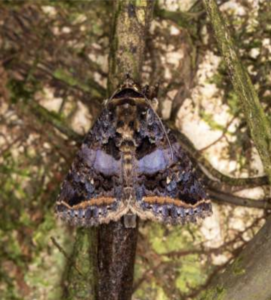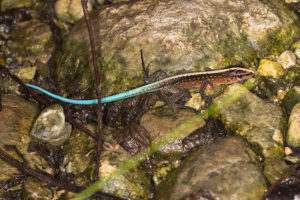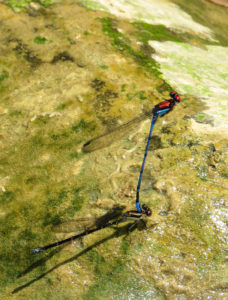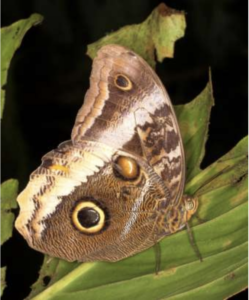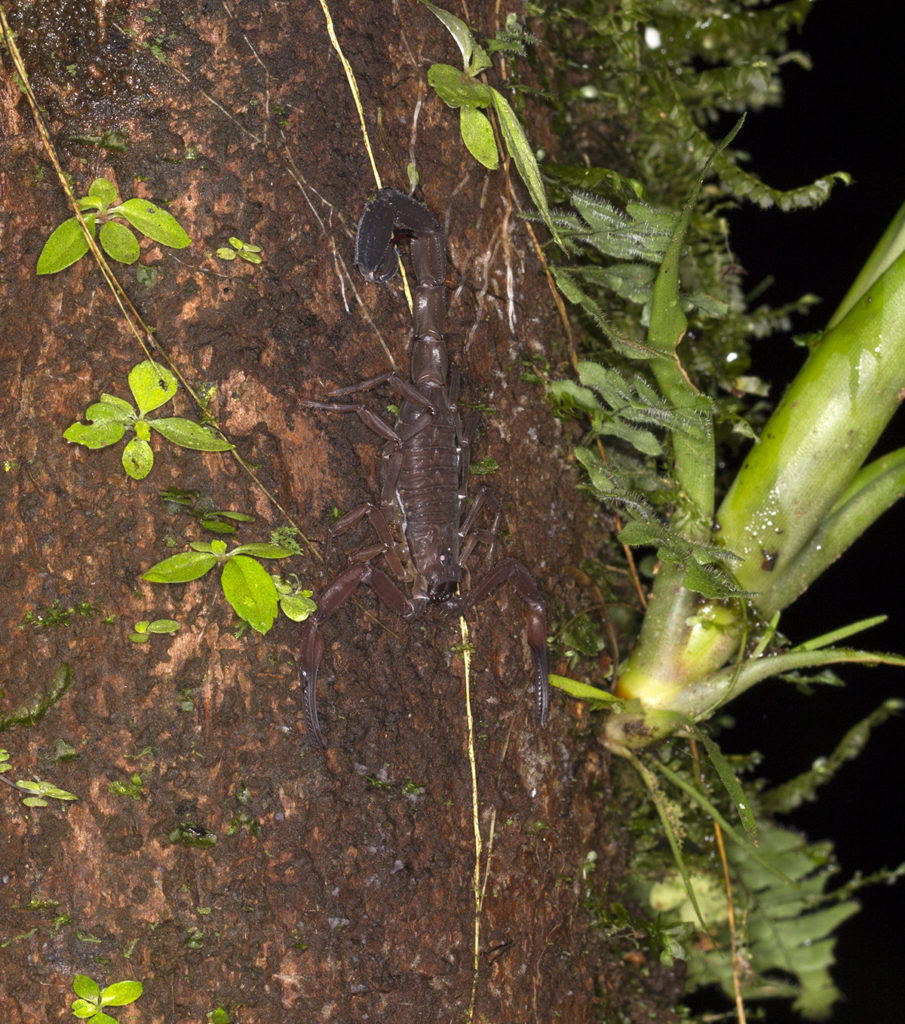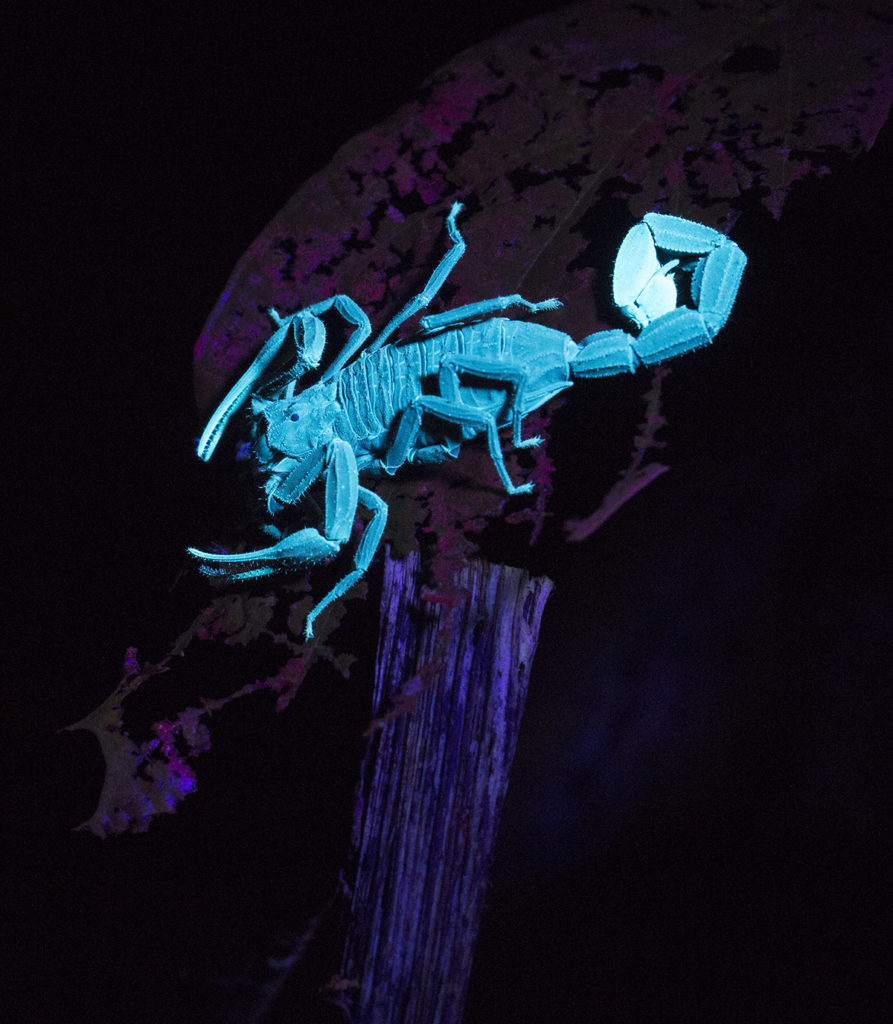As an owner and part-time resident at the Finca, I hear from a lot of guests that they love their visit but didn’t see many animals or birds. In this blog I hope to address a few ways to get the most out of your visit and enjoy the amazing natural world that surrounds our treehouses.
First of all, this is rainforest, which means it is tall and dark and full of places for animals to conceal themselves. If you want to see medium to large mammals, it is best to visit a savannah or dry forest where visibility is easier, but before you give up, there IS a lot going on in the forest and forest edge at the Finca, you just need to change your perspective and expectations a bit. Seeing a Blue Morpho slowly flapping past you on a trail, looking for tiny poison dart frogs, listening to the dawn chorus from your canopy-level perch are all amazing natural experiences.
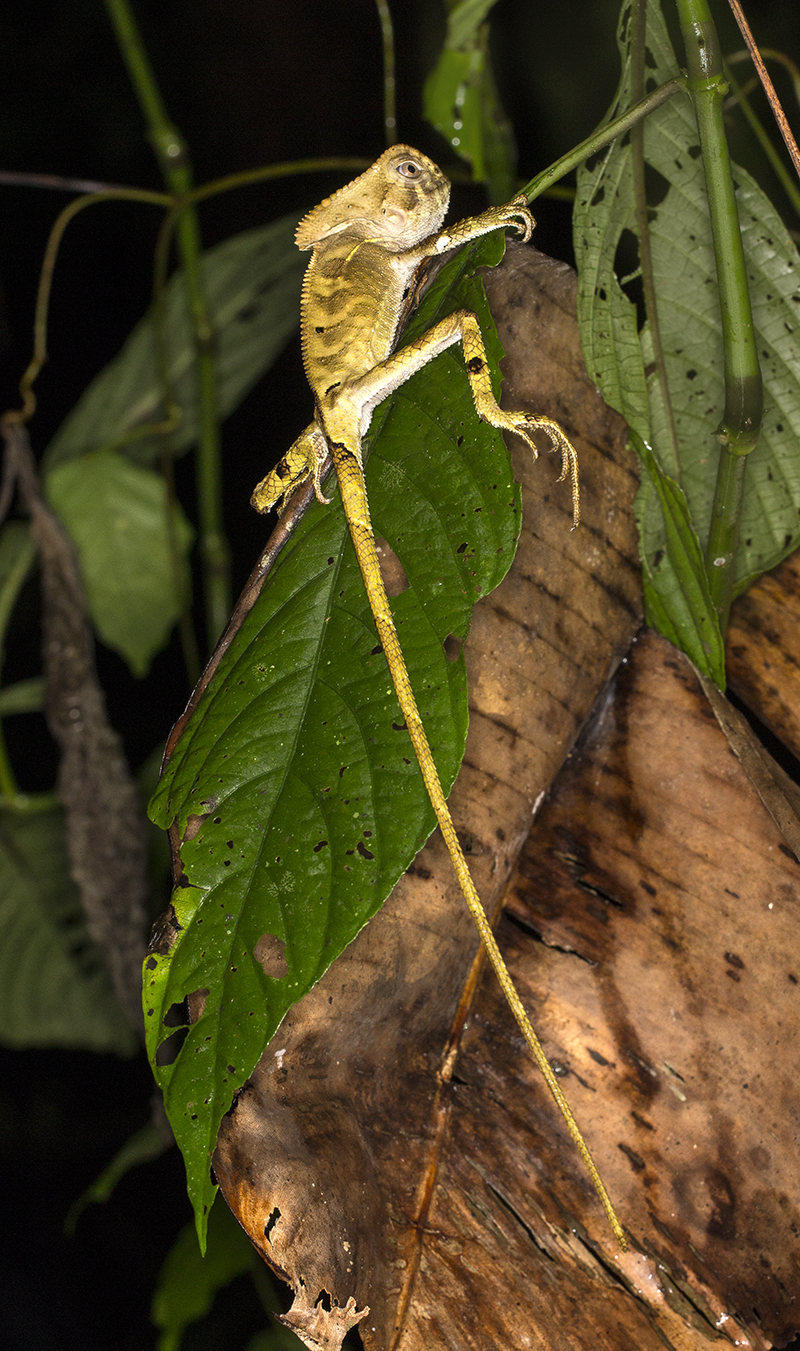
Helmeted Iguana
I’m going to list some useful equipment and how to make the most of it during your visit to the Finca.
Camera
It doesn’t matter if you only have a phone camera, or a small point and shoot (if you are weighed down with sets of lenses you can skip this section), you can get some great shots on your visit. Just keep in mind the forest interior is dark. It is a good idea to practice taking pictures in low light and experimenting with your flash and macro. You should take a night hike at the Finca (more about that a bit later) as you will have opportunities to get close to some amazing insects and frogs. It will really help if you are familiar with how to use your camera on a macro setting, how to use the flash, and to have already tried out settings for low light. If you have a pop-up flash, try wrapping a bit of tissue over the flash to diffuse the light (you can practice at home in a dark room with some flowers or buds as subjects).
- Noctuid moth
- Festive lizard, juvenile
- Mating damselflies
- Owl butterfly
Binoculars
I would never leave home without my binoculars. They are so useful, not just for birds, but for monkeys, sloths, that lizard sunning on a rock, a dragonfly and all the creatures that like to keep their distance. They are great at night too, if you have a good flashlight or headlamp. Binocs are described with two numbers, e.g. 7 x 42 or 8 x 30. The first number is the magnification or power. The best ones are 7 or 8 x. The second number is the diameter of the front lens (the one farthest from your eyes). The larger the number, the brighter and sharper your image will be. Another important component of binocs is the “field of view”, i.e. the area you can see when looking through them. Compact binoculars have a small field of view and lack brightness. Close your hands until you can only see a pinprick of light through each fist. Now look around – do you think you can even find the branch that you saw a small bird light upon? Attractive for their light weight, compact binocs are not recommended for birding in general and especially not in forest. They can be great for insects and lizards as they do focus close, allowing you to see a small bug that landed on your foot. I’d suggest getting a pair of 7 x 42 or 8 x 42 regular size binoculars. Spend as much money as you can afford (at least $300). Cheap binoculars will not do well in humid conditions, tend not to focus close, and fall apart relatively quickly. Try them in the store if possible, and see how close they focus and how bright and large the image is. Binoculars have another use that isn’t widely known – turn them around and look through the wrong end and bring your hand up close to the eyepiece. They can be used as a magnifying glass! Thus they are very helpful for removing splinters, looking at flowers, examining a fallen butterfly wing, etc.
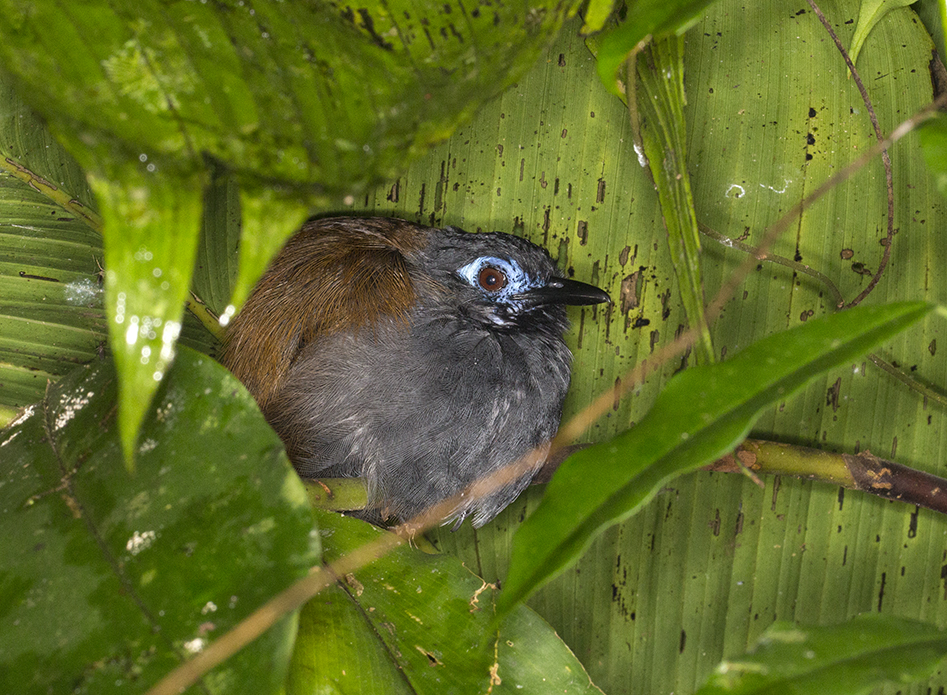
Chestnut-backed Antbird
Flashlights and headlamps
You must have a portable light for each member of your group, and a phone flashlight is not adequate (but can be a good backup). I’d highly recommend getting a headlamp (head torch to UK guests). Try to find one that has a bright and dim setting (why they all have strobes I do not know, not for our purposes as naturalists for sure!) and/or one that has a light beam that can be focused. Headlamps enable you to look in the direction your eyes are moving, which is much easier than waving around a flashlight. Plus you have a hand free which is always nice. But the great benefit of a headlamp is that it allows you to find eye-shine reflected by numerous nocturnal animals. When you hold a light close to your own eyes (as when wearing a headlamp) it is much easier to see the reflection coming back from a spider or a kinkajou’s eyes than when you are hand-holding a flashlight. The animals that can be found easily from their eye-shine are: most spiders (but not tarantulas), which have twinkly bluish eye-shine, moths with reddish eyes, frogs (usually reddish), owls (dull orange) nightjars (bright orange) and many nocturnal mammals (eye-shine red, orange or bluish). If you acclimate yourself to the lower setting of your headlamp, you can switch to a bright setting when you see a distant mammal. Or you can use the headlamp with a wide beam and change to a narrow beam when you want a better look. Another option would be to bring a spotlight with a highly focused beam and only use this when you find a mammal in the canopy.
UV Light
This might seem a bit specialized for your visit (please don’t go looking for a crime scene!), but small UV lights can now be obtained at most hardware stores. These are fun to use at night as certain animals and plants fluoresce in UV. Scorpions are extremely hard to find with a flashlight, but very easy with UV. Look for them on trunks of trees, rock piles and alongside paths. When you cross the bridge to the forest trails there are usually several scorpions visible on the rock walls of the canyon and on tree trunks in this area. Moths are attracted to UV so you might consider bringing a white pillowcase and hanging this outside your treehouse with your UV light shining on it (the white background just increases the light capacity of the UV light). You will find moths, katydids and other creatures attracted to the light.
A few not-so-nice insects may also be attracted to light, UV or incandescent, so you will need to keep your house closed up. Sometimes tiny no-see-ums appear, and they do bite. To keep these small pests off your skin you can apply baby oil (other oils probably work too), as they seem to drown in the oil before they bite. No-see-ums can get through some screen mesh, but can be outwitted by placing a brighter light outside and using a dimmer light for inside.
- Can you see the scorpion on the left
- See how clearly it stands out under the UV light?
Bat Detector
This is another rather specialized piece of equipment. A young child with good high-frequency hearing can also be used! These days you can buy tiny bat detectors that fit your smartphone (Echometer touch series) and enable you to hear their calls. A review of many bat detectors can be found here: https://batdetecting.blogspot.com/. Many of the treehouses have bats on outer screens or in the wells around the support tree. It can be fun watching them prepare to fly off at dusk or return at dawn. They may give audible calls for social purposes, but most will use high-frequency calls once they are in flight.
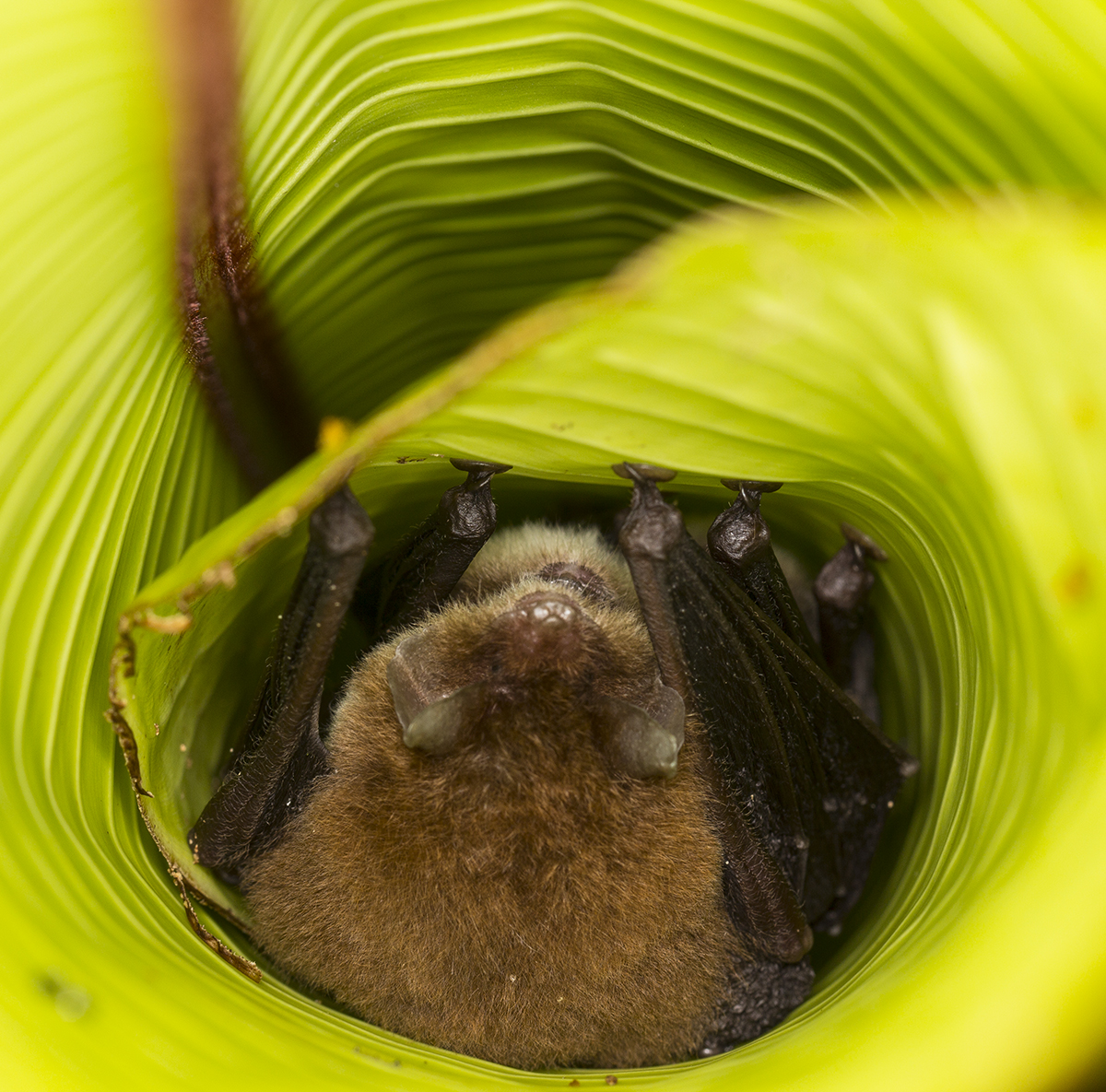 Disc-winged Bats in coiled leaf
Disc-winged Bats in coiled leaf
Finding Birds
In tropical forest, many birds travel in mixed feeding flocks. This means you may see or hear no bird life then all of a sudden there are dozens of birds moving through the trees. It is wonderful to witness this from high up on your treehouse deck, as you can see many species at eye level. If you are on the ground and suddenly hear birds, the first thing you should do is look down! Many birds follow army ants, and you may well find you are standing on a large column of ants. This is one of several reasons to wear those rubber boots you will be offered on arrival. Stamp your feet and move off the ants (untangling bats from nets at night I have on occasion been forced to strip off and de-ant myself, this is what happens if you stay in one spot and don’t check the ground around you – not fun!). Birds are difficult to spot and identify in the forest. You should start by looking at the numerous birds around Base Camp. Many species nest around the rancho and office, and this area allows for better views. In the forest it can help to familiarize yourself with the calls of common species. You can google these and look up their calls:
Chestnut-backed Antbird (very common near the ground in all forested areas)
Riverside Wren (common along Green Trail and start of Red Trail – perches in low shrubs)
Orange-billed Sparrow (a pair can be seen at intersection of Green and Red Trail area)
Chestnut-mandibled (or Yellow-throated) Toucan (very distinctive call)
Fiery-billed Aracari (a small toucan with a squeaky voice)
Whistling Wren (perches low in forest)
While you are looking up calls, you could also try to find calls of Kinkajou, Red-backed Squirrel Monkey, Granular Poison Dart Frog, Masked Treefrog and Tungara Frog. All of these frogs can be heard after a rain (the first mostly by day, the next two at night).
Night Walks at the Finca
Like it or not, you will most likely be walking forest trails at night if you attend any dinners or happy hours (both recommended). It is a great idea to join one of the Finca’s Night Tours as you will see much more with a guide than on your own. At night you can see and get much closer to a range of creatures you might not see and certainly can’t study up close during the day. Anoles (small lizards) sleep on leaves and twigs and allow a close approach. Walking sticks, katydids and numerous other insects are easily found at night. Slow down and peer under leaves (you can do this by day too) and examine tree trunks. Keep an eye on the ground in front of you and slow down more! Look into the canopy and listen for the sound of falling leaves as a mammal moves about overhead. Wear those rubber boots!
Exploring the River
It is possible to walk stretches of the lovely Bellavista River. Be aware that the water can rise quickly and you do not want to be trapped in a canyon when this happens. Water shoes (Tevas for example) are highly recommended, and a swimsuit for cooling off. Look for dragonflies in quiet pools on the sides of the river. On a rock somewhere nearby a Common Basilisk has its eye on you – try to locate it before it dashes off. Riverside bird species often bob. If you see a bobbing bird with a pale yellow rump it might be a Buff-rumped Warbler or a Sulphur-rumped Flycatcher. Another bird that bobs is the Spotted Sandpiper. Look for animal tracks in sandy patches. Trails near the river are good for frogs, glass-wing butterflies, morphos and helicopter damselflies. If you are lucky you may see a Coati or Tayra coming down for a drink.
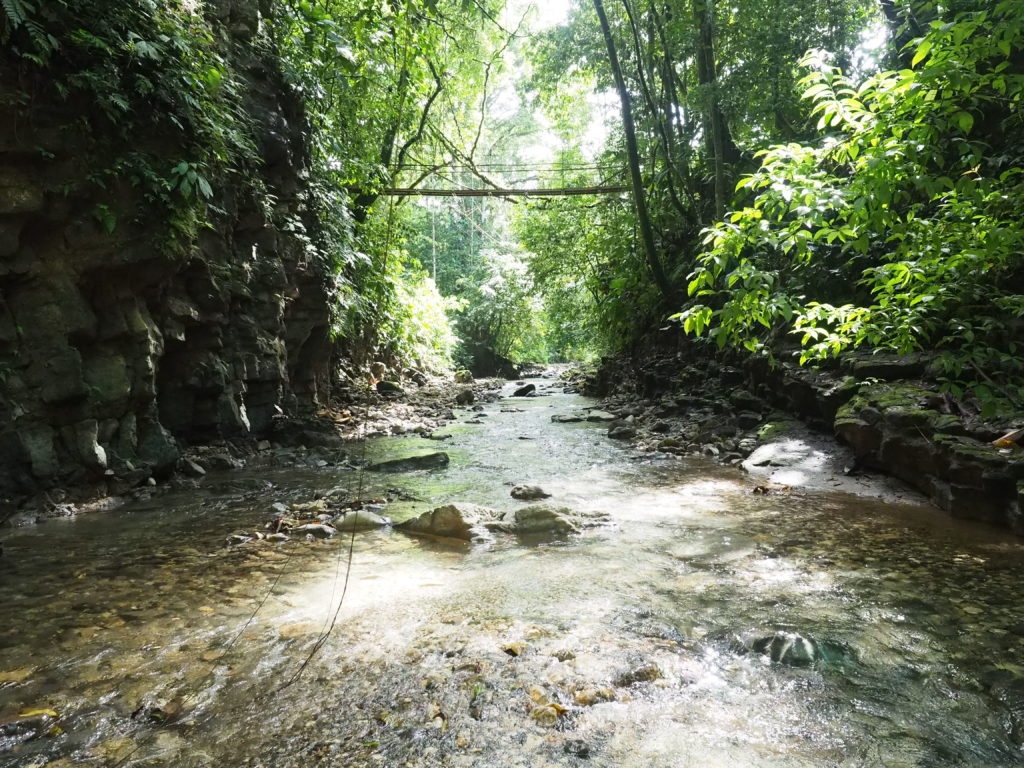
River at Finca Bellavista
Slow down, walk softly, and enjoy this wonderful wild place with all it has to offer the naturalist.

Fiona Reid owns El Fenix treehouse at FBV. She is a biologist and artist who has written and illustrated numerous books on mammals, including the Peterson Guide to Mammals of North America and A Field Guide to the Mammals of Central America and Southeast Mexico. She studies bats and other small mammals, but she also enjoys all aspects of tropical nature. Fiona decorated her treehouse with a mural of her forest view, and the first animal to be depicted on the mural was the Granular Poison Dart Frog.

